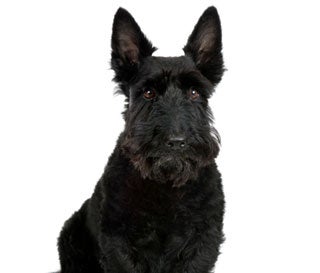Learn about dog breeds
Detailed information & photos on over 190 different breeds
Description
Also known as the Scottie Dog and Aberdeen Terrier, the Scottish terrier is a strong, sturdy, compact little dog that has its own unique and distinctive profile and shape. This short, heavy legged little dog has a weather resistant coat, good bone structure, and thickset body. The Scottie has small, almond shaped, black or dark brown eyes, sharply pricked ears, and large teeth and nose. Their big paws, sturdy legs, muscular body and neck make them excellent diggers, which is something that they love to do. No fence can hold this small dog if it decides to dig an escape route so they require loving, consistent, firm training to prevent this. These terriers should be on a leash or fenced because they will run after other small dogs and animals.
Scotties are one of Scotland’s five terrier breeds that include West Highland White, Dandle Dinmont, Cairn, and Skye Terriers. An extremely popular dog, while in the White House, President George Bush owned one and President Roosevelt had Fala, a Scottish terrier. Other famous Scotties include ‘Jock’ from Lady and the Tramp and Carnegie Mellon Universities official mascot.
Coat Description
Scottish terriers have compact coats that are wiry, stiff and harsh with soft, full undercoats to protect them from harsh weather conditions. With beard-like hair on their face, and their back, tail, ears, and head trimmed close, these dogs have a unique, adorable shaggy look. Jet black or very dark grey are the most common coat colors but there are also brindle and wheat which are rarer.
History
Originally named after a Scottish city, they bred the Aberdeen Terriers or Scottish Terriers to dispel vermin. These dogs worked on farms hunting den animals such as wildcats, badgers, foxes, and other varmints, and became territorial towards their farm and family. It was not until 1917 that the Great Britain’s Kennel Club banned interbreeding. Although the stylish, wonderful Scottie is mainly a companion animal today, it still has its hunting instincts.
Temperament
Alert and brave, the Scottish terrier is a lovable, hardy, protective little charmer full of spunk and character, which makes them extremely popular. A friendly, playful puppy, the Scottie often matures into a dog with changeable moods and behavior making them playful and happy one minute, and snappish and bossy the next but, if trained well, will be a faithful and loyal pet. They are very aware and alert dogs so make excellent watchdogs. Usually independent, they require socialization and training starting at a young age to keep them from becoming overly aggressive or trying to take over their human family as the boss. Dogs that do not receive proper training and socialization may become aggressive and chase or even attack other dogs and animals.
An extremely loyal family dog, these terriers seem to pick one or maybe two members of the family and bond closest to them. They are great with older children but are not a dog for young children. Standoffish and reserved around strangers, they have very little interest in people outside their immediate family.
Scotties make excellent household pets that are playful, sporty, love their family and enjoy chasing things, playing ball, going for walks, digging and barking.
Health Problems
Scotties are a healthy breed of dog but are at risk or prone to problems such as:
[-]Scottie Cramp[/-]
[-]Jaw problems[/-]
[-]Flea and skin allergies[/-]
[-]Van Willebrand’s disease[/-]
[-]Elbow Dysplasia[/-]
[-]Bladder cancer[/-]
[-]Malignant Melanoma[/-]
These dogs are also prone to several types of cancer and many veterinarians recommend that terriers have no contact with smoke, herbicides or pesticides. Provide them with plenty of fresh air, exercise and a good vitamin enriched diet.
Grooming
The Scotties long, wiry, harsh coat requires brushing regularly once every week or two to help prevent mats, tangles and to remove dead or loose hair and dander. Have your pets coat professionally trimmed two or three times a year to keep the dog looking its best. The hair on the terriers face is brushed forward and slightly trimmed while the hair on the dogs body looks almost like a skirt because it is left long Show dogs require hand stripping, which is a grooming method where they pull the terrier’s hair out instead of cutting it. As the new hair grows in, it has a wiry look and feel. Clipping instead of hand stripping is fine for family pets as it is less expensive, easy to do yourself, and the hair is very velvety and soft.
Exercise
Like all dogs, Scotties do require exercise but receive a large percent of theirs indoors playing with family members. These little terriers love games such as hide and seek, catch, or running around playing in the house or in a secure, fenced yard or area. They also enjoy daily walks, which give them exercise and helps them from becoming overweight.
Training
Scotties require socialization and training at a very young age. Dogs that experience new sights, sounds, places, people, and situations grow up to be well adjusted and not overly aggressive or shy. Always use positive training methods and keep the session’s fun, short, and positive. Avoid negative enforcement such as raising your voice because the Scottish terrier will become very stubborn. Rewarding the dog with praise or food treats works well. Scotties adjust to country, city, or life in the suburbs and can live in a small apartment or large home as long as they receive sufficient exercise.
Advertise | Privacy Policy | Terms of Use | Contact Us © Copyright 2004-2024 PupCity.com. All rights reserved.
